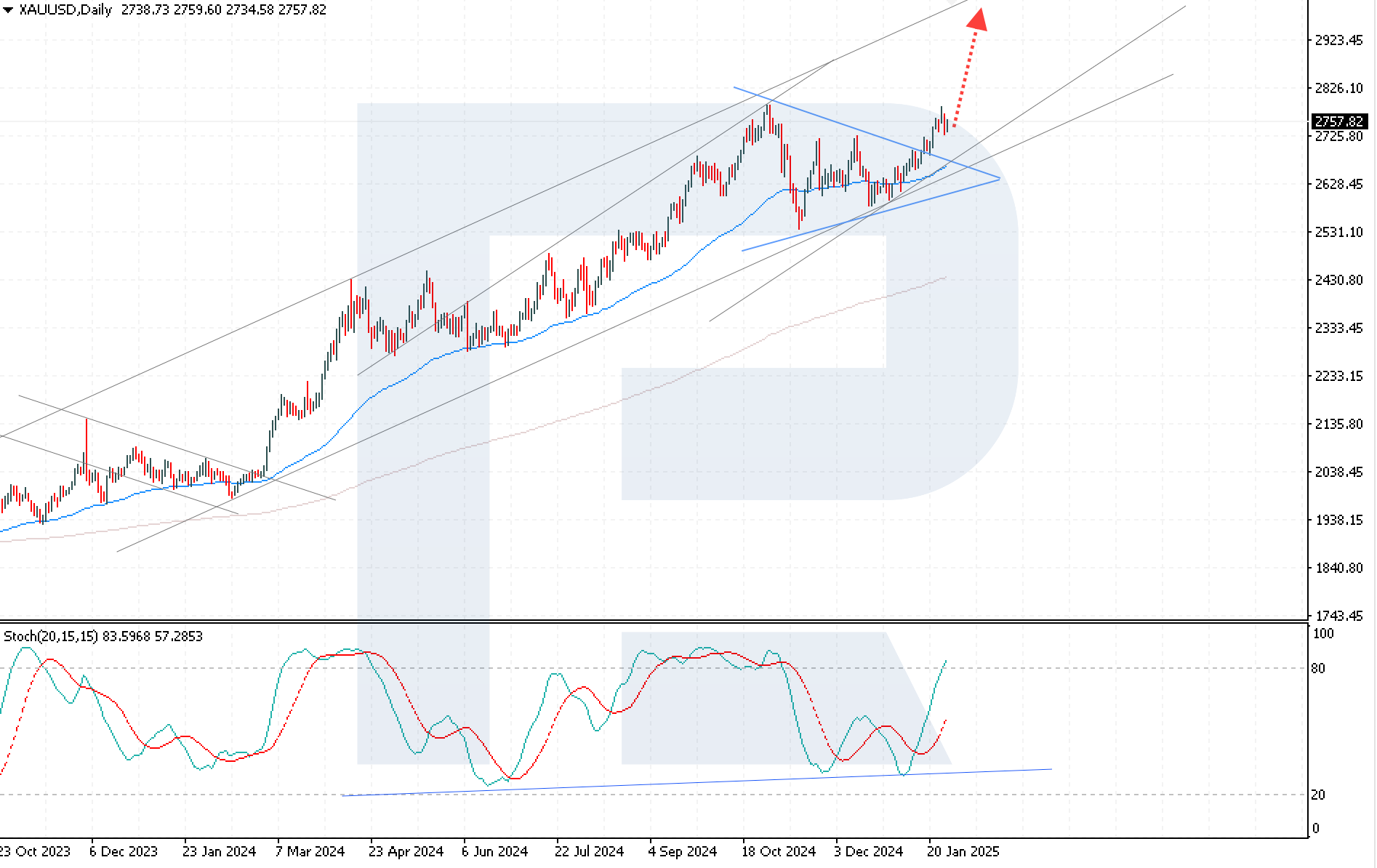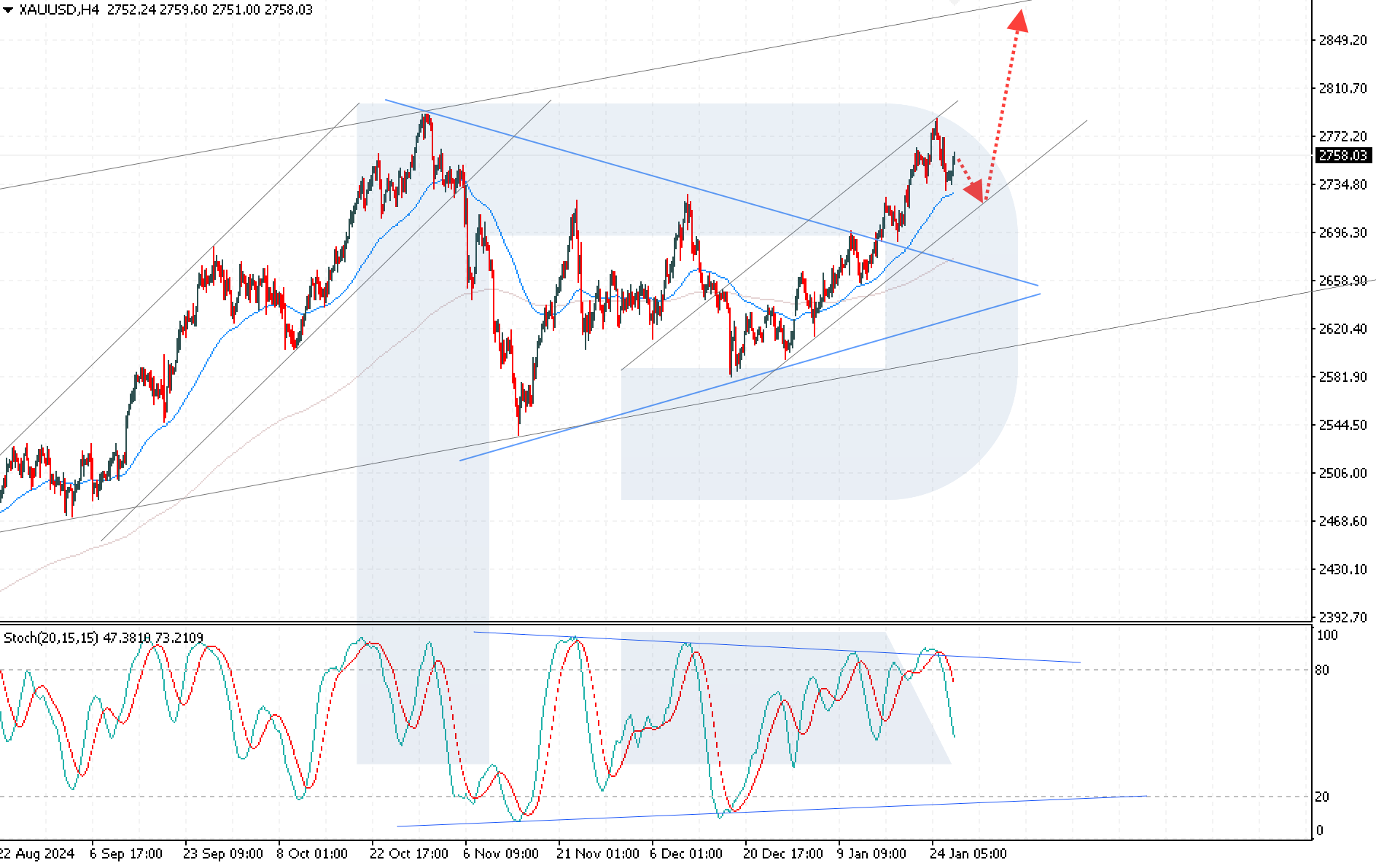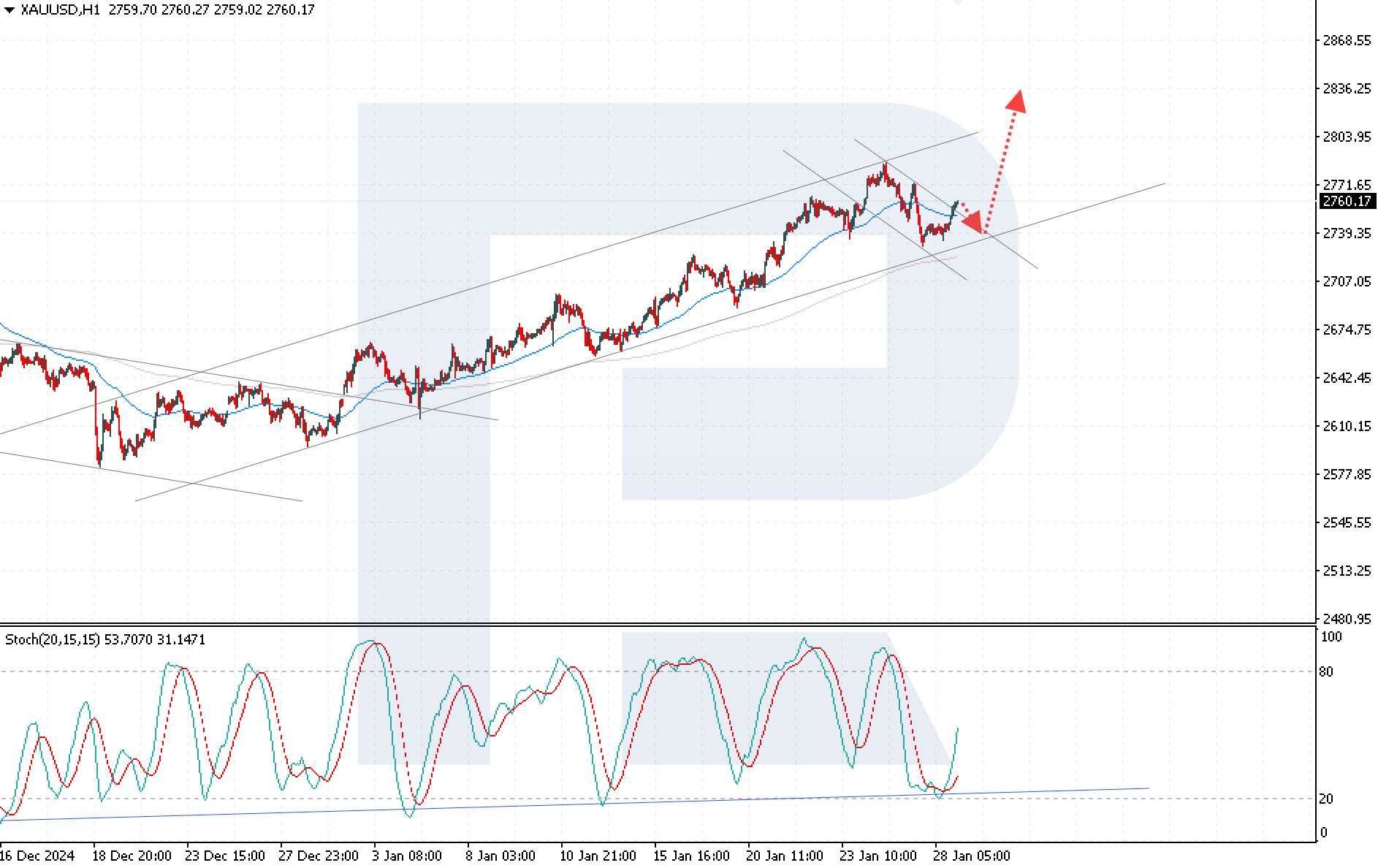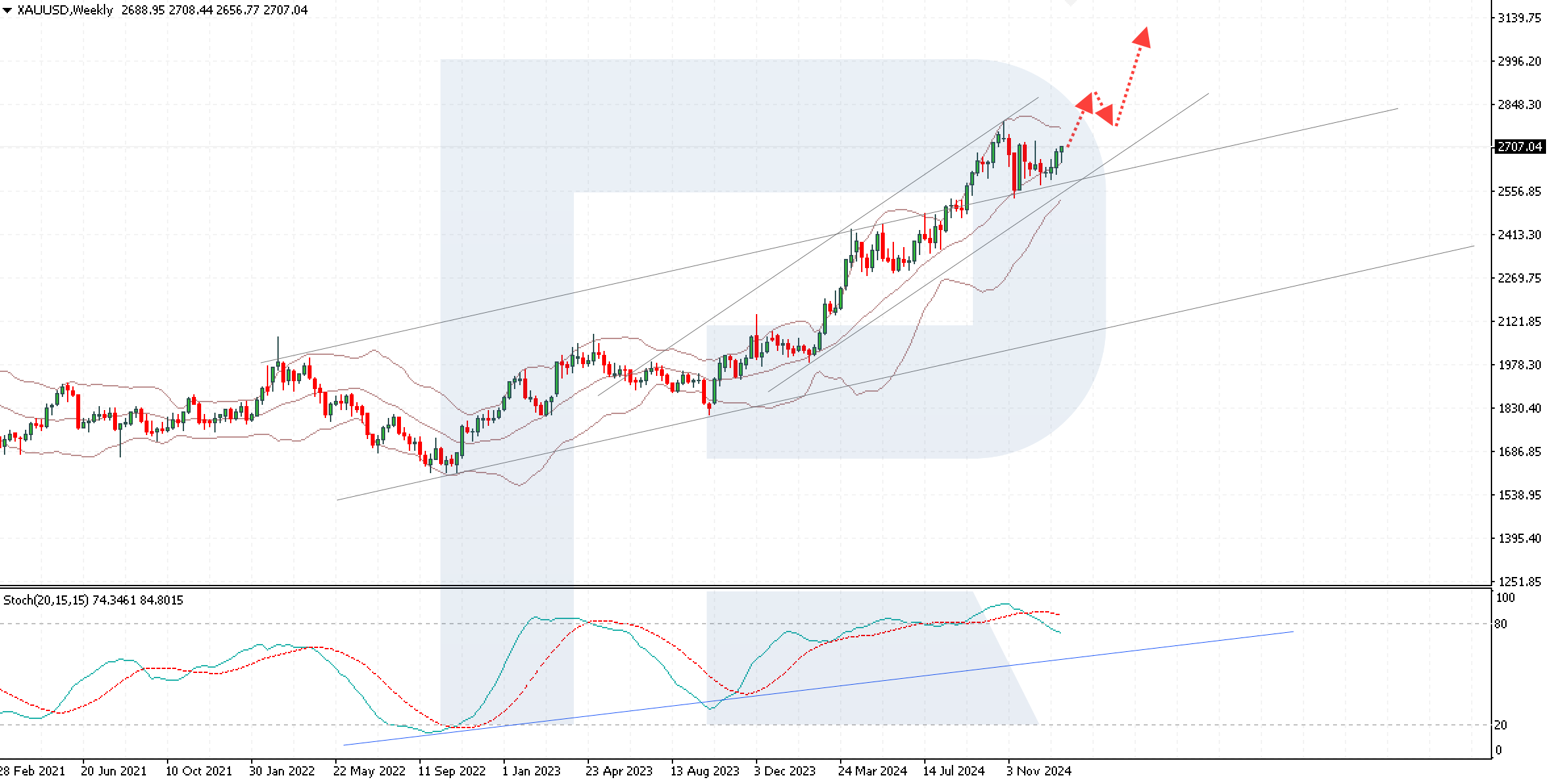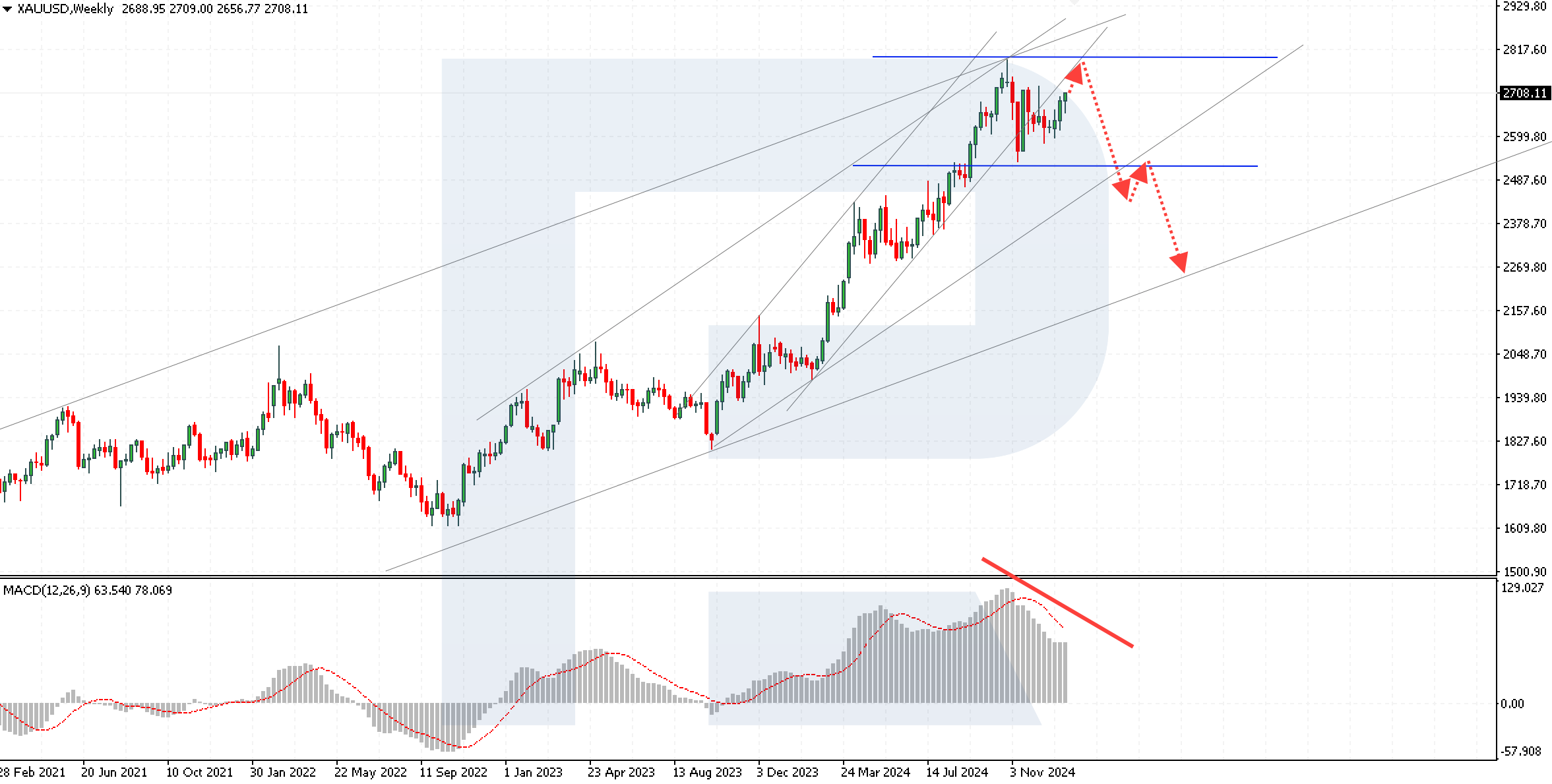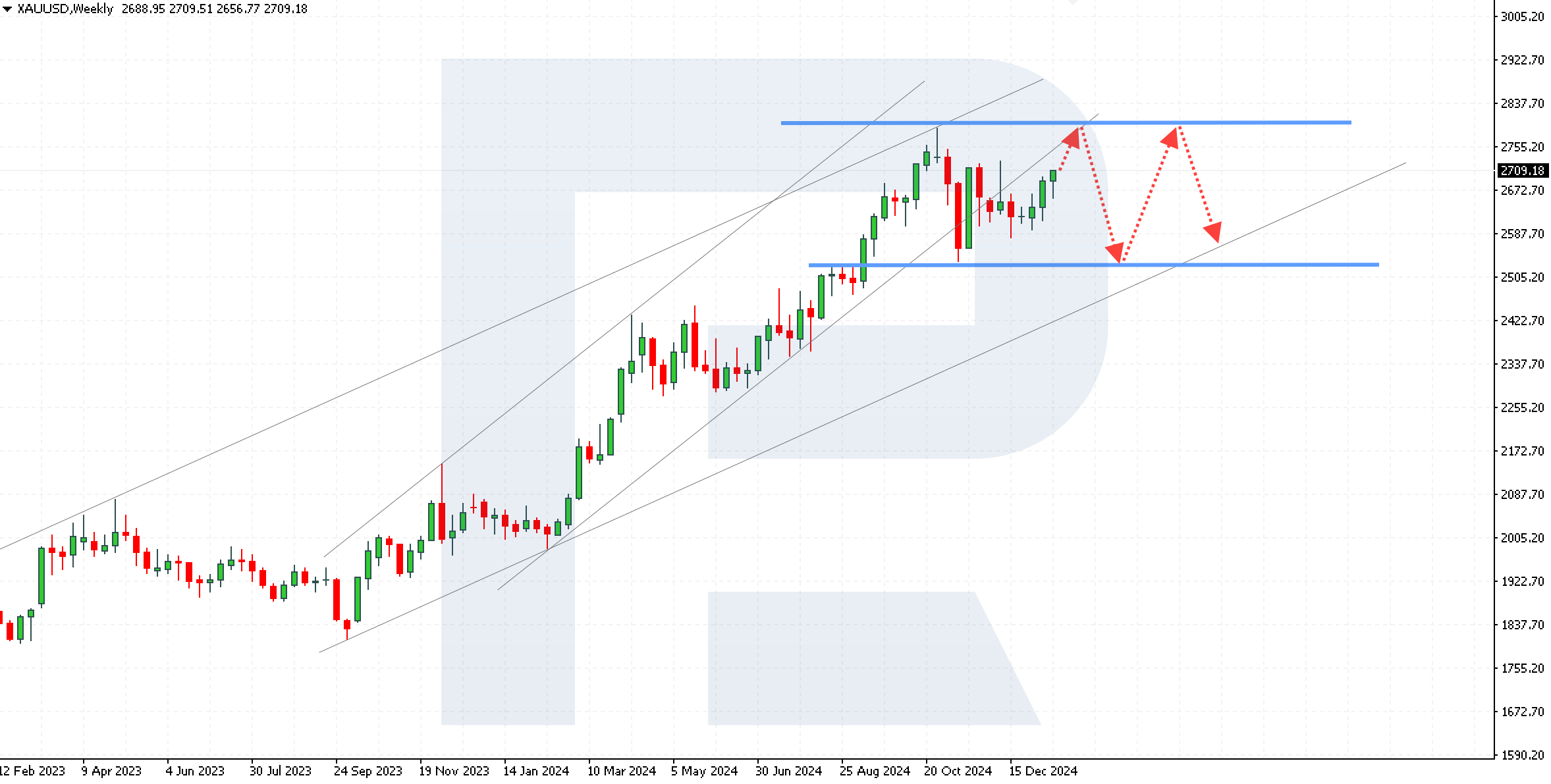Gold (XAUUSD) forecast 2025 and beyond: expert insights, price predictions, and analysis
Disclaimer: the information in this article is based on the analysis of reputable financial resources and analytical data from RoboForex specialists. It reflects the conclusions of thorough research, but it should be taken into account that economic changes may significantly affect market conditions, which may lead to changes in Gold forecasts. We recommend conducting your own research and consulting with professionals before making important financial decisions.
Gold remains one of the most reliable tools for hedging risks during global crises. Its popularity confirms the enduring appeal of this asset, which is projected to persist in the long term.
After impressive growth in 2024, the gold market entered a consolidation phase, trading within the range of 2,725–2,575 USD per ounce at the beginning of 2025. Over the past year, the XAUUSD rate increased by 27%, reaching a peak of 2,790 USD per ounce on October 31, 2024. Despite the current stabilisation, analysts remain confident in gold's potential in 2025, predicting its movement toward the key level of 3,000 USD.
The escalation of the conflict in Ukraine, tensions in the Middle East, and political instability in Europe continue to heighten economic uncertainty. These risks contribute to growing demand for gold among investors and central banks. Notably, the People's Bank of China resumed purchases in December after a six-month pause, once again becoming the largest buyer of the precious metal.
Table of contents:
- Key takeaways: Gold (XAUUSD) price prediction
- How to make a Gold price forecast?
- Why has the price of Gold increased?
- XAUUSD 2025 live price chart
- Gold (XAUUSD) weekly technical analysis
- Long-term Gold (XAUUSD) technical analysis
- Expert Gold price forecast 2025 and beyond
- Expert Gold price predictions for 2030
- Pros and cons of investing in Gold
- Conclusion
- FAQ
Key takeaways: Gold price prediction
Analysts predict a continued rise in gold prices, with the possibility of reaching record levels in 2025. It is expected that the price of gold (XAUUSD) could reach 3,000 USD and, over the next two years, rise to 3,700 USD. This growth is attributed to high demand from major central banks and changes in the monetary policy of the U.S. Federal Reserve.
Gold remains an attractive asset amid declining confidence in the U.S. dollar in the East and ongoing geopolitical tensions. In its assessment, Morgan Stanley expects gold prices to stabilise at 2,700 USD in the first quarter of 2025, while UBS forecasts a XAUUSD increase to 2,900 USD by the end of the year. Experts at Goldman Sachs believe gold could reach 3,000 USD in 2025.
Particular attention is being paid to gold reserve purchases by central banks in developing countries, aiming to reduce dependence on the dollar and mitigate risks associated with sanctions. Analysts emphasize that the increase in U.S. government debt will pressure confidence in the American currency in the long term, contributing to further growth in XAUUSD.
How to make a Gold price forecast?
Gold price forecasts are based on the analysis of the main factors determining its supply and demand. It also takes into account the price patterns on the price chart, the assessment of technical indicators, as well as the dynamics in emerging markets. Experts and investors distinguish three main approaches that allow to make an accurate XAUUSD forecast:
- US monetary policy
- Central bank purchases
- Geopolitical risks
These key drivers are significantly influenced by the level of confidence in the US dollar and its current strength or weakness. Other important factors analysts highlight include changes in investor sentiment, political instability during the election period, the threat of recession, ETF outflows, physical demand sensitivity, the US unemployment rate, and bank and industry risks in the US and China.
Fundamental factors
Fundamental analysis of Gold (XAU/USD) relies on changes in monetary policy by central banks, especially the US Federal Reserve, as well as other key factors affecting the Gold price. These include the level of global consumption, investment in the metal, increased demand from central banks, the Fed rate cut and the suspension of Gold purchases by China. These factors significantly influence the price dynamics and form the basis for further forecasts on Gold.
Fed interest rate cut
Gold has traditionally shown a close correlation with the dynamics of interest rates of central banks. Historically, gold has shown steady growth in the context of falling interest rates and accelerating inflation, acting as a risk hedge. The shift in the monetary cycle in the U.S. was one of the factors driving gold prices higher in 2024. In September 2024, the regulator lowered the interest rate by 50 basis points for the first time since 2020. The regulator also noted that a new phase of the easing cycle had begun, and in 2025, decisions on interest rates will be made more cautiously.
Global demand for Gold
According to the World Gold Council's Q3 2024 report, total Gold demand rose 5% y-o-y to 1,313 tonnes, a record high for Q3. The total value of demand exceeded 100 billion USD for the first time, occurring amidst high investment levels at record Gold prices.
Global investment demand doubled to 364 tonnes thanks to increased interest in ETFs, mainly from Western investors. ETFs in Gold added 95 tonnes, marking the first positive quarter since early 2022. Meanwhile, demand for bars and coins fell 9%, but the annual total remains strong at 859 tonnes, above the 10-year average of 774 tonnes.
Demand for Gold in the technology sector increased by 7% due to increased use in electronics, supported by the artificial intelligence boom.
Gold purchases by central banks
Central banks purchased 1,037 tonnes of Gold in 2023, the second highest annual volume of Gold purchases in history, behind only the record of 1,082 tonnes purchased in 2022. This data confirms Gold's status as a reliable reserve asset for global economies. According to The World Gold Council, net Gold purchases by central banks more than doubled to 37 tonnes in July 2024. This represents a 206% increase on the previous month and the highest monthly total since January, when 45 tonnes were purchased.
According to the 2024 survey of 70 central banks, 29 per cent of respondents plan to increase their Gold reserves over the next year - the highest figure since such surveys began in 2018. The main reasons cited for increasing reserves include a desire to achieve optimal reserve levels, support for domestic Gold production, and fears of financial crises and inflation.
Central banks of developed countries traditionally have a large share of Gold in their reserves. For example, in the US, France, Germany and Italy, Gold accounts for about 70 per cent of reserves. In emerging markets, this figure is much lower - in China, Gold accounts for only 5.7% of reserves. However, central banks in emerging markets are actively building up their Gold reserves in an effort to reach levels similar to those of developed economies, which could support future Gold growth.
China has stopped buying Gold
The Central Bank of China has refrained from buying Gold for its reserves over the past six recent. China's Gold reserves stood at 72.8 million troy ounces at the end of October 2024, with the value rising to USD 199.06 billion from USD 191.47 billion at the end of September. The share of Gold in the total reserves of the People's Bank of China, an important indicator for many central banks, increased to 5.7% at the end of October, up from 4.9% in April.
Investors speculate that another one month without Gold purchases may indicate that China is waiting for more favourable prices to build up its Gold reserves. Overall, however, China continues to stick to its strategy of accumulating foreign exchange reserves and intends to significantly increase its Gold reserves, limiting its purchases due to high metal prices.
Tech analysis
This approach involves analysing historical data on Gold charts to identify price trends using various technical indicators, chart patterns and other analytical tools. Technical analysis helps to identify key resistance and support levels, trend lines, as well as to predict possible price reversals over the long term.
Based on historical data, we see that XAU/USD, as a rule, demonstrates an upward trend in the long term. Therefore, trend indicators such as Moving Averages, Bollinger Bands and the Ishimoku indicator are often used to analyse it. Oscillators such as RSI and MACD help to identify where the downward correction may end and signal possible upward reversal points.
Market sentiment
The main fundamental factors supporting the growth of XAUUSD price remain stable. Sustained demand from major central banks, which are actively increasing their Gold reserves, continues to contribute to a positive mood in the market. This is particularly evident in emerging markets, where central banks are seeking to diversify assets and reduce their dependence on the US dollar.
Increasing geopolitical tensions, including in the Middle East, are adding to global uncertainty, prompting investors to seek safe assets such as Gold. In Q3, a significant driver of demand for Gold was capital inflows into Gold ETFs. After a period of declining demand, these funds showed net inflows for five consecutive months, indicating an active reallocation of capital by institutional investors and fuelling further growth in prices for the precious metal.
Why has the price of Gold increased?
The rise in gold prices in 2024 was driven by multiple factors, including geopolitical instability. Conflicts in Ukraine and the Middle East, as well as political crises in Germany and France, heightened investor concerns. Additionally, the U.S. Federal Reserve’s easing of monetary policy amid slowing inflation reduced the appeal of debt assets, stimulating demand for gold. Central banks in developing countries and China increased their purchases of the precious metal, aiming to reduce dependence on the U.S. dollar and minimize sanction risks. Retail investors in countries such as China, India, Turkey, and Russia also stepped up their gold purchases, using it as a hedge against the depreciation of their national currencies.
Macroeconomic factors also influenced demand for gold. The growing U.S. national debt and declining confidence in the American dollar boosted interest in gold as a safe-haven asset. Policies from the Trump administration, including plans to impose import tariffs and the removal of the debt ceiling limit, increased uncertainty, further strengthening gold's position. Renewed interest in gold ETFs and the precious metal's weak correlation with other asset classes made it a popular choice among retail investors. In 2025, these factors continue to reinforce gold's status as an asset capable of preserving value amid rising market volatility and political instability.
XAUUSD 2025 live price chart
Gold (XAUUSD) weekly technical analysis
The key resistance is located at the level of 2790 USD, breaking which will open the way for further price growth within the framework of the model. The target in this case is the level of 2920 USD. The Stochastic Oscillator indicator also signals the continuation of the upward trend due to the crossing of the %K and %D lines. The support zone is located in the range of 2650–2700 USD, and its breakdown may indicate a trend reversal and the start of a decline.
On the H4 chart of XAUUSD, the quotes continue to move within the medium-term upward trend. Since the crossing of the EMA-65 and EMA-285 lines, the gold price has not once tested the fast moving average EMA-65, confirming the growing pressure from buyers. According to the main forecast for XAUUSD for 2025, the development of a bearish correction to the level of 2730 USD is expected, after which growth to the level of 2865 USD is likely to resume. A rebound from the resistance line on the Stochastic Oscillator indicator enhances the likelihood of short-term decline. Consolidation of the price below the level of 2695 USD will signal a deeper downward correction.
On the hourly chart of XAUUSD, the price has consolidated above the EMA-65 line, continuing to move within the upward channel. The breakout of the quotes beyond the downward correction channel indicates increased buyer interest and the likelihood of further growth. In the short term, testing the broken channel boundary at the level of 2740 USD is forecasted, followed by the development of a bullish impulse to the level of 2835 USD. Additional support for the growth scenario is provided by the crossing of the %K and %D lines on the Stochastic Oscillator indicator. Breaking the lower boundary of the upward channel with price consolidation below the level of 2725 USD could signal the beginning of a bearish correction.
Long-term Gold (XAUUSD) technical analysis
When creating a long-term forecast for XAUUSD prices, it is important to consider several potential scenarios. The forecast will highlight key support and resistance levels and analyse the behavior of prices within the Bollinger Bands indicator. By examining how often and how strongly prices manage to break through one side of this trend indicator, we can gain a better understanding of current market trends and investor sentiment. It is worth noting that when breaking through key levels, XAUUSD may either accelerate its upward movement or enter a correction depending on changes in the external economic environment.
Bullish scenario
On the weekly timeframe, XAUUSD quotes have consistently remained above the middle line of the Bollinger Bands indicator since the end of 2023, indicating a prevailing bullish trend. Currently, prices also remain above this line and regularly break through the upper boundary of the indicator, signaling increasing pressure from buyers. In a positive scenario, and based on the XAUUSD price forecast, further growth of the precious metal’s prices can be expected, with a breakthrough of the nearest resistance level at 2,720 USD. Consolidation above this mark will likely lead to testing the upper boundary of the Bollinger Bands at 2,815 USD. In the past, there has been accelerated growth upon breaking the upper boundary of the indicator; therefore, if prices consolidate above the 2,815 USD level, a continuation of the bullish trend can be expected, with the first target at 3,000 USD.
Bearish scenario
A potential bearish scenario is associated with the formation of a bearish divergence on the MACD indicator. If XAUUSD prices rise to the 2,790 USD level, this signal could fully form, creating conditions for a reversal and triggering a decline in XAUUSD quotes. The nearest downside target will be the key support level at 2,500 USD. Breaking through this level will pave the way for a deeper decline down to the 2,255 USD level as part of the implementation of the "Double Top" reversal pattern. This pattern occurs when the price tests a resistance level twice and then breaks the support level, confirming a trend reversal.
Sideways scenario
XAUUSD quotes have already demonstrated a rebound from resistance at the 2,795 USD level, subsequently falling to support at 2,535 USD and bouncing off it. Currently, prices are rising again and approaching resistance. If buyer pressure proves insufficient, another pullback to the 2,535 USD support level is possible. If prices fall again and sellers fail to breach the support, prices may resume growth, remaining within the sideways range. This scenario would indicate market uncertainty and anticipation of new factors that could determine the future direction and push prices out of the range.
Expert Gold price forecast 2025 and beyond
J.P. Morgan
J.P. Morgan maintains a bullish forecast for gold in 2025, highlighting its attractiveness as a hedging instrument amidst macroeconomic uncertainty. Analysts expect gold prices to reach 3,000 USD in 2025, with further growth driven by political and economic risks.
UBS
Despite the slowdown in the Fed's rate cuts and potential strengthening of the U.S. dollar, demand from central banks, de-dollarization, and the growing U.S. deficit will support gold's appeal. UBS forecasts the XAUUSD price to rise to 2,850 USD in 2025.
SaxoBank
Saxo Bank notes that gold will remain an attractive asset for hedging economic instability in 2025, amid geopolitical uncertainty and inflation risks. Gold prices are expected to rise to 2,900 USD despite volatility caused by U.S. dollar fluctuations.
Commerzbank
Commerzbank expects the XAUUSD price to stay at around 2,600 USD in 2025. The forecast is based on expectations of a Fed rate cut, which will support demand for gold as a safe-haven asset during economic instability.
ANZ
ANZ forecasts gold prices to reach 2,900 USD in 2025. The beginning of a monetary easing cycle in the U.S. is expected to support gold price growth. Key fundamental factors will also contribute to this growth.
Macquarie
Macquarie predicts that gold could set a new record in 2025 as the Fed lowers interest rates and central banks continue to increase their gold reserves. Gold may face challenges in Q1 2025 due to a stronger U.S. dollar, but prices are expected to rise afterward. Analysts forecast gold could quickly reach 3,000 USD if demand from China increases or if Donald Trump's policies worsen the U.S. fiscal situation.
Goldman Sachs
Goldman Sachs adjusted its forecast, postponing gold's achievement of 3,000 USD to mid-2026, due to fewer anticipated Fed rate cuts. Nevertheless, gold retains growth potential, though the price increase is now expected to be more moderate than previously estimated.
Bank of America
Bank of America anticipates gold reaching 3,000 USD in 2025, though the current consolidation phase may last until mid-year. Experts note that weak demand from China and risks related to a stronger U.S. dollar present obstacles to the precious metal's growth.
Citi Research
Citi Research has raised its three-month gold forecast to 2,800 USD, citing potential labor market deterioration in the U.S., expected Fed rate cuts, and increased gold purchases by both individuals and ETFs. The 2025 forecast has also been raised to 3,000 USD.
Expert Gold price predictions for 2030
Many experts agree on the long-term bullish trend of the XAUUSD price as various fundamental factors point to it. Below are some of the expert opinions:
Charlie Morris, Head Of Multi Asset, Atlantic House Investments in the article in Alchemist magazine predicts a possible XAUUSD price of 7,000 USD per ounce by 2030. His prediction is based on several key factors. First, real inflation is expected to increase, which Morris believes could reach 4 per cent per decade. Second, real interest rates are expected to change. In addition, a fair value premium is factored in, which could increase substantially. These assumptions are based on analyses of current and past trends in the economy and the Gold market.
Another analyst Peter Leeds predicts that the XAUUSD price could reach 10,000 USD per ounce by 2030, driven by a number of economic and geopolitical factors. The main drivers of growth are the weakening of the US dollar due to the huge national debt, the growing budget deficit and its decreasing role in international trade, especially with the reduced use of the petrodollar. The BRICS countries, which are actively building up Gold reserves, are also having an impact: their new Gold-backed currency is expected to become a serious competitor to the dollar. An additional growth factor will be global economic instability and the growing demand for Gold as an ‘insurance’ asset.
The author emphasises that XAUUSD prices will grow annually, but the timing of reaching the 10,000 USD mark depends on the speed of development of the processes mentioned above. The key triggers may be the intensification of geopolitical conflicts, devaluation of the dollar or mass transition of investors to Gold. To maximise the benefits, it is recommended to invest both in physical Gold and in shares of Gold mining companies with low debts and high reserves. Gold remains a solid defence against economic turmoil and loss of purchasing power of currencies.
Pros and cons of investing in Gold
Gold has long been one of the most popular instruments for capital protection and risk mitigation. Even though it has many advantages, such as protection against inflation and portfolio diversification, it is important to consider the disadvantages of investing in this asset. For an investor, knowing the pros and cons of investing in gold helps in making informed investment decisions.
Pros
- Inflation protection: Gold traditionally serves as a reliable hedge against inflation. As prices rise and the purchasing power of currency falls, Gold maintains or even increases its value, helping investors protect their savings.
- Portfolio diversification: Gold can add diversification to an investment portfolio because its value typically has low correlation with stocks and bonds. Therefore, the price of this precious metal often moves in the opposite direction, reducing overall portfolio risk.
- Liquidity: Gold is a highly liquid asset that can be easily bought and sold on global markets. This makes it attractive for investors who may need to quickly convert their assets into cash.
- Safe-haven in crises: during periods of economic or geopolitical instability, XAUUSD is often seen as a "safe haven" asset. Investors tend to invest in the metal amidst uncertainty, which often supports and can even increase the value of gold when other assets may be declining.
- Tangible asset: unlike stocks or bonds, Gold is a physical, tangible asset that can be held and stored. This gives investors a sense of confidence and security compared to digital assets.
- Long-term value preservation: over time, Gold has maintained its value, making it a reliable means of preserving wealth through generations. It is less susceptible to risks associated with fiat currencies and other financial assets.
- Global demand: Gold is in demand worldwide, both as a commodity for industrial use and as a store of value. This global demand supports stability and provides potential for price growth.
Cons
- Lack of passive income: unlike stocks or bonds, Gold does not generate passive income, such as dividends or interest. Investors can only rely on the appreciation of Gold, which can be unpredictable.
- Volatility: despite its reputation as a stable asset, Gold can exhibit significant short-term price fluctuations. These fluctuations can lead to losses for investors focused on short-term gains.
- Storage costs: physical Gold requires secure storage, especially when held in large quantities. This adds additional costs that can reduce the overall profitability of Gold investments.
- Lack of yield: Gold does not generate income, unlike bonds or stocks. This can be a drawback for investors seeking regular passive income from their investments.
- Dependence on global factors: the value of Gold depends on numerous factors such as supply and demand, economic indicators, and geopolitical situations. This means that Gold prices can be subject to external shocks over which investors have no control.
- Market manipulation risks: XAU/USD prices can be affected by market manipulations, especially by large financial institutions or states, which can lead to unpredictable price changes.
- Opportunity costs: investing in Gold means essentially locking capital in a non-yielding asset. This can lead to missed opportunities for investing in other assets that may offer higher returns over time, such as stocks or bonds.
Conclusion
The rapid growth in XAUUSD prices in 2024 was driven by political and economic instability, including geopolitical conflicts and the Federal Reserve's monetary policy easing. Central banks, especially those in developing countries, increased gold purchases, while retail investors actively used it as protection against inflation and currency depreciation. Additionally, the growing U.S. national debt and plans from the Trump administration supported demand for gold as an asset to hedge against uncertainty and volatility.
Based on technical analysis, XAUUSD continues to maintain an upward trend on the chart. Buyers have managed to keep the price above the EMA-65 line for an extended period. The gold forecast for 2025 suggests a potential rise to levels of 2,810 USD and 2,985 USD, provided there is a confident consolidation above the nearest resistance at 2,735 USD. The Stochastic Oscillator indicator confirms bullish activity, signaling the possibility of further growth. However, a breakout below the lower boundary of the symmetrical triangle, with prices consolidating below 2,575 USD, could trigger a "bearish" correction down to 2,420 USD and 2,325 USD.
XAUUSD forecasts for 2025 range from moderate to optimistic. Overall, analysts predict price growth, with estimates varying from 2,600 USD to 3,000 USD. It is expected that the Fed's interest rate cuts, as well as demand from central banks and investors—including physical purchases and ETFs—will support prices. However, the possible strengthening of the U.S. dollar and higher bond yields could pose risks to growth. Despite this, gold retains the potential for upward movement, particularly if political instability or economic risks intensify.
FAQ
Whether it's a good time to buy Gold depends on current market conditions, economic indicators, and your financial goals. Given Gold's role as a hedge against inflation and currency devaluation, it can be a wise investment during periods of economic uncertainty or when inflation is expected to rise. It's important to consider both the current Gold price trends and broader economic forecasts before making a decision.
It is likely that investing in Gold can provide significant long-term benefits. Historically, Gold has maintained its value for centuries, providing a hedge against economic instability and inflation. It is an effective way to diversify an investment portfolio, as its price movements tend to differ from stocks and bonds. However, like any investment, it comes with risks and should be balanced with other types of investments to manage overall risk.
Today's Gold price forecasts can be found in the RoboForex Market Analysis section.
Experts predict an increase in gold prices to 3,000 USD, although it is currently trading within the range of 2,600–2,700 USD. A Fed rate cut could support the market, but rapid growth is not expected. Bank and analyst forecasts for 2025 range from 2,600 to 3,000 USD, with the strengthening of the U.S. dollar and rising bond yields potentially triggering a decline in the price of the precious metal. Nevertheless, remains a reliable safe-haven asset, especially against the backdrop of political instability and economic threats. Purchasing gold now may be justified, considering these factors and being prepared for associated risks.
While returns on any investment are not guaranteed, Gold could be profitable over the next five years, especially if economic or geopolitical conditions create uncertainty or instability. Gold’s historical performance during such times suggests that it could appreciate in value under similar future conditions. Investors should pay attention to global economic indicators and central bank policies, as they will play an important role in shaping Gold market dynamics. Diversification and careful monitoring will be key to managing investment risk and capitalizing on potential market opportunities for Gold.
Forecasts presented in this section only reflect the author’s private opinion and should not be considered as guidance for trading. RoboForex bears no responsibility for trading results based on trading recommendations described in these analytical reviews.

